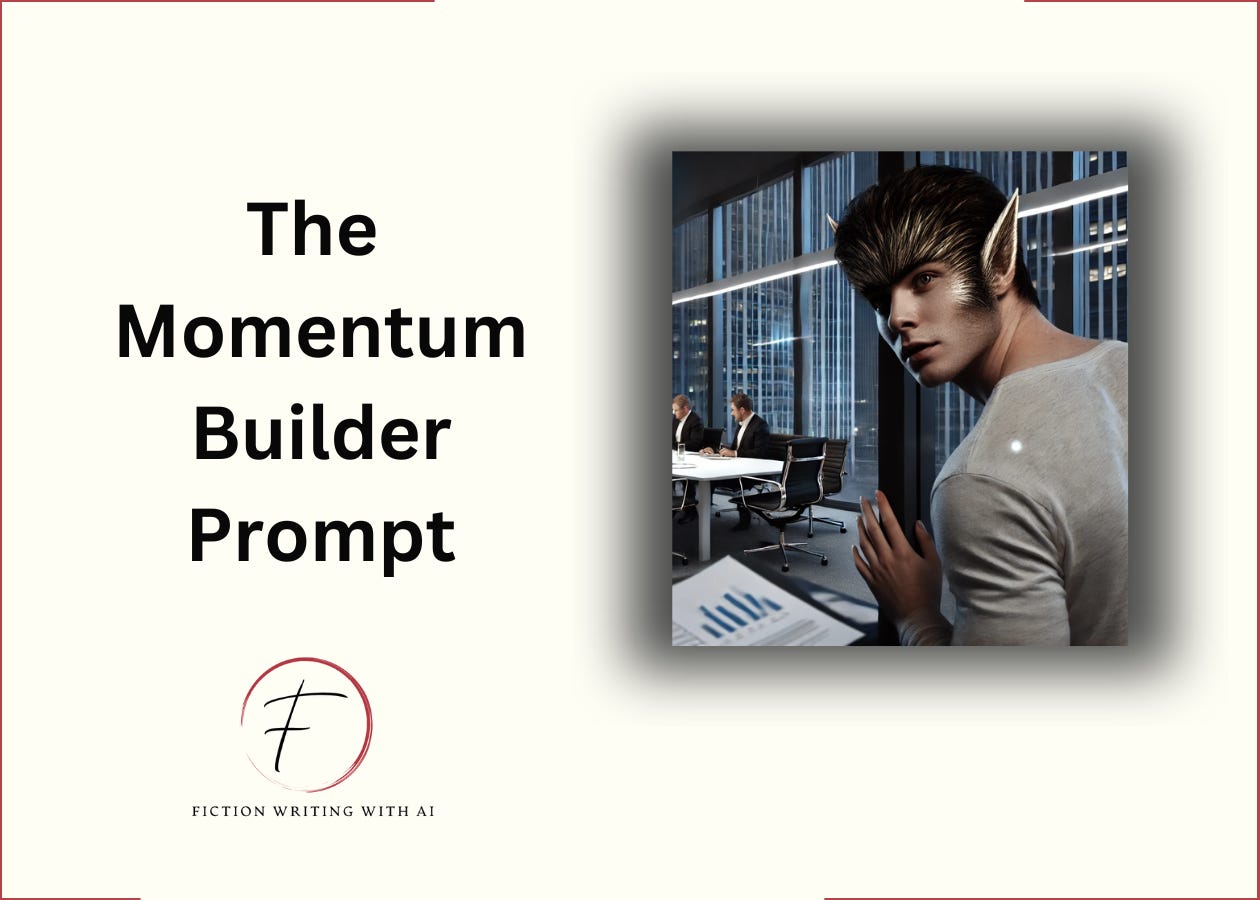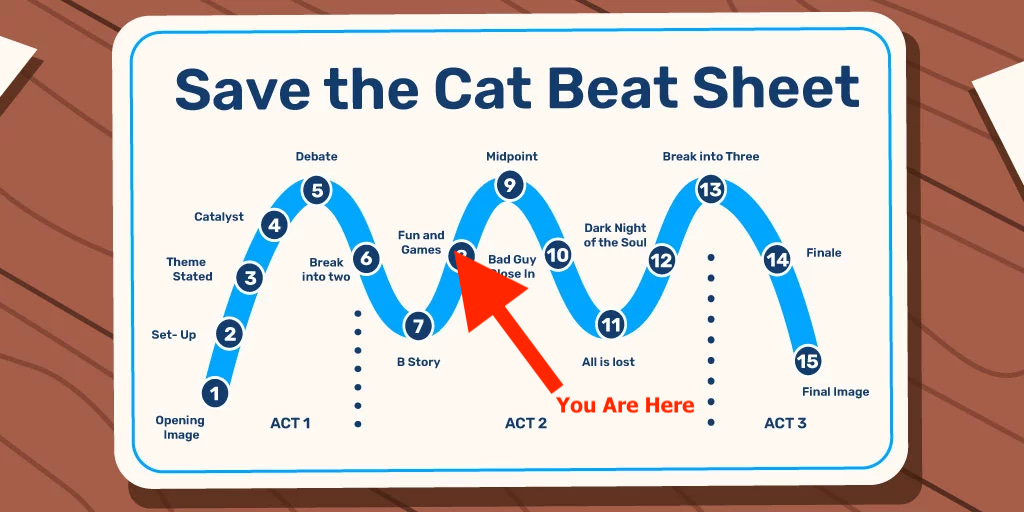Hey there!
Blake Snyder called it "Fun and Games."
But for most writers, it's more like "Frustration and Guesswork."
This section of your story should be filled with "trailer moments" and genre-specific awesomeness. Instead, it often turns into a meandering mess of half-baked scenes and on-the-nose exposition.
Why?
Because most writers misunderstand what "Fun and Games" really means.
(Hint: It's not about making things easy for your protagonist.)
Today, we're going to dissect the "Fun and Games" Formula—and I'll show you how to use AI to generate ideas that will make this section the page-turning heart of your novel.
Ready to turn your "meh" middle into a masterpiece that builds unstoppable momentum?
Let's dive in.
The "Fun and Games" Formula
The Fun and Games section of your story falls after the B Story beat and before the Midpoint.
It's the heart of your story's second act. And it’s the reason readers will pick up your book. If you promised them "werewolves on Wall Street" in your premise, then this is where you show them furry traders howling at the moon while juggling stocks and hostile takeovers.
This section is a series of trailer worthy moments, each followed by a “bouncing ball” of consequences, with subplots woven throughout.
It breaks down like this:
Trailer Moment: A big, promise-of-the-premise scene
Bouncing Ball: The immediate aftermath, including successes and failures
Subplot Weave: How this impacts or is impacted by ongoing subplots
Build to Next Moment: How this sets up the next big scene
Take "Harry Potter and the Sorcerer's Stone" for example.
Trailer Moment 1: Harry's First Flying Lesson
Bouncing Ball: Harry discovers his natural flying talent (success). Gets in trouble for disobeying Madam Hooch (failure).
Subplot Weave: Deepens rivalry with Malfoy, strengthens friendship with Ron
Builds to: Being made Seeker for Gryffindor team
Trailer Moment 2: First Quidditch Match
Bouncing Ball: Harry catches the Snitch, Gryffindor wins (success). Nearly falls off jinxed broomstick (failure).
Subplot Weave: Hermione suspects Snape, trio's bond grows stronger
Builds to: Increased suspicion about the Sorcerer's Stone
Trailer Moment 3: Forbidden Forest Detention
Bouncing Ball: Harry encounters centaurs, learns about unicorns (success). Comes face-to-face with Voldemort (failure).
Subplot Weave: Neville's involvement shows his growing courage
Builds to: Trio's determination to protect the Stone
Now, let's put this formula into action for your novel:
Step 1: Revisit Your Story's Core Concept
Remember that killer premise you came up with?
Time to dust it off.
If you promised them a tale of werewolves in Wall Street, then it's time to deliver some furry finance.
Step 2: List Your "Trailer Moments"
Think of your story like a movie.
What scenes would make the cut in your book's trailer?
These are your "promise of the premise" moments. The stuff readers came for.
For example:
Werewolf transforming during a board meeting
Full moon trading floor frenzy
Alpha werewolf hostile takeover
List 5-7 big scenes that deliver on your story's promise.
These are your "trailer moments.
Step 3: Plan Your "Bouncing Ball"
Here's where most writers mess up.
They make everything too easy for their protagonist. Readers are sadists. So, your "Fun and Games" should be a rollercoaster of ups and downs.
Think of it as a bouncing ball:
Small victory
Bigger setback
Glimmer of hope
Crushing defeat
Unexpected ally
New obstacle
For each trailer moment, brainstorm immediate consequences—both positive and negative.
Example for "Full moon trading frenzy":
Success: Record-breaking profits, promotion buzz
Failure: Suspicious colleagues, SEC investigation rumors
Keep that ball bouncing.
Step 4: Weave In Subplots
Remember the subplots we brainstormed last week?
This is where they shine.
Let them complicate things by intertwiting them in the plot. Create conflict. Raise the stakes.
List your B-story subplot(s) and how they intersect with each trailer moment.
“Vampire lover provides insider info for the trading frenzy, but this deepens the conflict between werewolf and vampire factions.”
Step 5: Build Towards The Midpoint
Every scene should be building momentum towards your story's Midpoint—the moment where everything shifts (more on this next time).
Are you heading for a false victory or a false defeat? Plan accordingly.
For each trailer moment, write one sentence on how it escalates the story towards your midpoint.
“The trading frenzy success raises the stakes by putting the protagonist in the spotlight, making it harder to hide his true nature and setting up a higher-pressure board meeting scene.”
Now, let's supercharge this process with AI.
The "Momentum Builder" Prompt
Let's see this in action with our Wall Street Werewolf thriller:
Story Premise: A rookie werewolf on Wall Street struggles to control his transformations while climbing the corporate ladder.
Genre: Urban Fantasy Thriller
B-Story: A forbidden romance with a vampire hedge fund manager.
Here's the prompt:
Keep reading with a 7-day free trial
Subscribe to Fiction Writing With AI to keep reading this post and get 7 days of free access to the full post archives.





